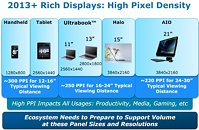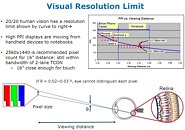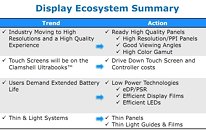Friday, April 13th 2012

Intel to Push for Higher Resolution PC Displays, Arrive in 2013
Come 2013, and PC consumers could finally break the shackles of regressive PC resolution "standards" such as 1366x768 and 1920x1080, if Intel has its way. At a presentation at IDF Beijing, Intel expressed its desire to see much higher resolution displays for all computing devices, not just PCs, which could in true terms be "retina-matched" display resolutions. At an optimal (comfortable) viewing distance, the resolution of a computing device's screen should match that of your eyes.
If Intel has its way, a 21" all-in-one desktop PC, and a 15" notebook PC screen will have a resolution of 3840x2160 pixels; a 13" Ultrabook PC could have a resolution of 2800x1800 pixels, a 11" Ultrabook and 10" tablet with 2560x1440, and 5" handheld/smartphone with 1280x800. Compare these to the $500+ 27" 1920x1080 monitors that are still sold in the market! A very bold proposal, but one only a company with the industry prominence of Intel can pull off.
Source:
Liliputing
If Intel has its way, a 21" all-in-one desktop PC, and a 15" notebook PC screen will have a resolution of 3840x2160 pixels; a 13" Ultrabook PC could have a resolution of 2800x1800 pixels, a 11" Ultrabook and 10" tablet with 2560x1440, and 5" handheld/smartphone with 1280x800. Compare these to the $500+ 27" 1920x1080 monitors that are still sold in the market! A very bold proposal, but one only a company with the industry prominence of Intel can pull off.



88 Comments on Intel to Push for Higher Resolution PC Displays, Arrive in 2013
Monitors like that in the US sell for like $400+ easily...
There's also a difference between what we can see (if we try) and what we need or is sufficient for a sense of fluid motion. This is from where most arguments come from. I think it's beyond proven that for the grand mayority of people, 24 fps and 72 Hz is enough to be "satisfactory", since that's what films are played on. Of course more is better, but there's probably a point not much higher where it becomes irrelevant to go higher.
But that is for motion pictures, on games it's vastly different, because while you game, your brain is not concentrated on the entire picture, it's trained to be focused on some select details like the enemy, so the rate at which it can "see" changes on those select areas is higher. Also low frame rate goes hand in hand with slow response time and bad mouse control and that can be more easily sensed by our brain too.
So high framerates are necesary and desirable for gaming, but usually people is wrong when they say they can "see" at very high frame rates. Most of people who claim that, if presented with a movie playing at 48 fps or 96 fps changing back and forth would not see the difference if they were watching the film.
it also depends on every individual... A fighter pilot is gunna see much more than Bob from California
In amovie your brain is more open to all the info that comes at each frame, thus less frames are not as harmful, though I'm sure everyone has noticed that the low framerate of movies is far far more evident on fast paced scenes with low details, such as a flying object with a completely blurred background.
Now to add to the topic, although I'd like these high resolutions I'd probably prefer good color at below $500 and faster response times and higher refresh rates, in that order, before higher resolution.
affordable price where nvidia Kepler,intel ivy bridge has support 4K resolution
for now 2560x1600/1440 still the greatest resolution for LCD at an affordable price
for 27-30"